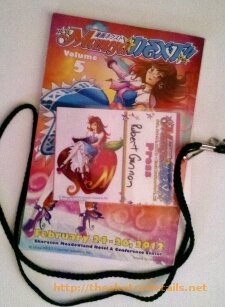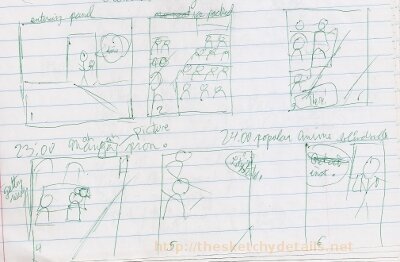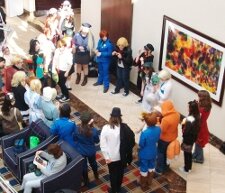Over the weekend, I had the pleasure of participating in a convention called MangaNEXT. I wasn’t entirely sure what I was getting myself into when I applied for a press badge to this convention. I just knew that the subject interested me.
Manga are Japanese comic books. They cover a wide variety of topics and are targeted to every market imaginable. There are manga for boys, manga for girls, manga for young men, manga for young women, manga for men, manga for women, etc., that all break down into many different subgenres and interests, likes sports, cooking, fantasy, or romance. Traditionally, the new manga start out in magazines. These magazines contain many stories in each weekly or monthly issue. The popular stories are then collected in tankoben, or volumes–small books of an individual title. Think of them like comic book anthologies. You get multiple issues in one book.
While I had an interest in the form and exposure to a few titles, I really did worry about what I was getting myself into. Did I know enough to even get anything out of the convention? Would I recognize any of the guests or cosplay? And most importantly, would I have to say “manga” before figuring out how people were going to pronounce it in this area?*

My credentials and the tankobon-styled convention guide.
Any fears I had dissolved quickly when I showed up to the central office to pick up my press credentials. Before I even had the chance to introduce myself, one of the many MangaNEXT staffers asked me what I was looking for. I was directed to the table where a trio of staffers were finishing up preparations for the press office. They could not have been nicer about greeting me and handling a few last minute details. Within a few minutes, I was presented with my freshly laminated press badge with my name front and center.
The name thing initially struck me as odd. Most conventions I’ve been to just hand out badges categorized by your ticket type. A press badge would just say press, while a one day badge would say one day or the valid day of admission.
Not at MangaNEXT. The purpose of this convention seemed to be fostering a sense of community among manga fans. Why shouldn’t you be able to walk up to someone and introduce yourself? You’re all there for the same reason. The ice breaking is done as soon as you go up the escalator to the heart of the convention.
This concept was confirmed when Ezra, the convention chair for 2012, delivered a lovely tribute to the culture of manga fans during the opening ceremonies. “It’s all about the love of manga and standing together and all the fans [uniting]!” Looking around the room, I could see the variety of people being united by an interest in manga. There were children and adults. There were people in elaborate cosplays and people wearing everyday clothing. No matter what the motivation for attending MangaNEXT was, everyone was welcome.

This cosplayer doing Beatrice from Umineko no Naku Koro ni gladly posed for photos every few steps she took.
This broad reaching approach resulted in a wide variety of engaging content all weekend long. Of course MangaNEXT had an Artist Alley and a Dealers Room. Most conventions do. And yes, they were packed with fans scoping out good deals on manga, art, autographs, and accessories all weekend long.
What stood apart was the range of panels, workshops, and activities to participate in. You could spend an hour learning about the breadth of apocalypse-themed manga. Maybe you wanted to learn all about paneling your own manga from an art teacher in a workshop that quickly filled to standing room only capacity. Perhaps meeting a variety of international manga artists and having a chance to win one of a kind artwork was more in your wheelhouse. Or maybe you just wanted to show up, dress up, and party all night long. These activities and so much more were readily available throughout the convention.
I unfortunately had to duck out early on Friday for music work, forcing me to miss out on panels about surviving cosplay emergencies, coloring manga, cartoon adaptations of video games, and ballroom dancing. I also knew that I couldn’t do any interviews because I was on call for another production that might have needed a last minute rehearsal during the weekend. I knew that I could not waste any time the rest of the weekend if I was going to get the full experience of the convention. Here’s how my Saturday went down.
I started off with back to back panels run by fans. The first was a loosely moderated discussion about bad anime. The panelists (the creative team behind YouTube series Underbelly) went toe to toe with audience members about how the shows went so wrong in translation and edits. The next panel (members of Disorganization XIII) became an engaging look at the fan fiction community through the lens of literary criticism. Cheekily titled “From Mary Sue to Shakespeare,” the goal was to open a fanfic writer or fan’s eyes to the context of the community as a whole. Both panels really set the tone for the rest of the weekend. As fans, we’re all equal and we all have valid opinions.
From there, I shifted over to the larger panel room for back to back Q&A sessions with Japanese manga artists. Tomo Maeda (Honey Blood; Black Sun, Silver Moon) and Makoto Tateno (Yellow, Romeo/Romeo) were met with a mix of fans, press, and curious con-goers who all had equal opportunities to ask questions and meet the artists. The artists took all of the questions in good humor, from queries about the process of creating manga to personal interests and inspiration.
I knew I wanted to see how the workshops were run, even if I myself had not considered creating manga before. First up was Jen Lee Quick (Off*Beat) doing a Q&A session about selling a manga or comic with a story bible. She generously handed out copies of the original story bible for Off*Beat. She also spent a lot of time engaging with the participants one on one about the creative process and any concerns they had.

Meta manga from a manga convention about creating manga at a manga convention
Lily Hana (
Farewell Feeling) ran a workshop called “Creating Manga from Start to Finish.” Instead, it became a workshop for the attendees on whatever they’re interested in. She polled the audience and spent the workshop teaching us all about panel layout in manga. She gave individual feedback on everyone’s storyboards and patiently answered any question thrown at her. She even put up with my nonsense which, in case you can’t tell from my…art(?), was a literal biography of showing up and getting the last seat for that workshop.
As if lessons in creation and easily accessible panels weren’t enough, I also chose to attend a few of the more specialized panels. The guys who run Spiraken Manga Review sped through an hour long panel on post-apocalyptic manga because the schedule fell behind. Their breakdown of different varieties of the apocalypse was still very engaging. Erin Finnegan (Anime News Network) also raced through a panel but for a very different reason. She set out to discuss the wide world of unusual manga genres and schooled the large audience on everything from pachinko manga to educational business school manga.
Saturday night ended with a series of events for the fans. Instead of a traditional Masquerade (think cosplay onstage), MangaNEXT introduced Iron Cosplay. Teams of four were pulled out of the audience to put on manga/convention themed skits. One team had to tell a giant robot story featuring a Final Fantasy hero, Derpy Hooves, a Time Lord, and a ballet dancer. In fifteen minutes, they came up with a crowd pleasing performance about a Time Lord abducting Derpy Hooves and a Final Fantasy hero to fight the evil giant ballet robot destroying the city. The hosts kept the event moving with live dancing and interactivity while the groups prepped their skits.
Now imagine the variety of panels, workshops, and events I didn’t get to at MangaNEXT. I didn’t get a chance to visit the manga library or watch the judging in the Hall of Cosplay. Every time I chose one panel, I was forced to skip two or three other panel events happening at the same time.

A group of cosplayers start an impromptu meet up at MangaNEXT
Now imagine hundreds upon hundreds of people navigating all these different events. There were people who seemed to unwittingly travel in groups the entire convention and people who never even got to see each other. Strangers joined forces to act out moments from popular manga and anime. People were talking, laughing, and just having a good time with like-minded con-goers.
No matter where I went at MangaNEXT, I was made to feel welcome. It didn’t hurt when a few guests and convention attendees recognized me either from NYCC or, by name alone, from Sketchy Details. But even total strangers who had no idea who I was or what I was doing there were inviting.
All conventions have their own unique feel to them. The events inevitably take on a life and persona of their own. I haven’t felt this comfortable at a convention this large in a long time. MangaNEXT welcomes everybody with open arms.
Thoughts? Love to hear them.
*The answer is “mahn-gah,” as what we translate from Japanese as “a” is typically pronounced as “ah.” And yes, that does mean that “ahneemay” is closer to the pronunciation of “anime” than you might typically hear. More importantly, I wasn’t the only person trying to get the word right this weekend.






